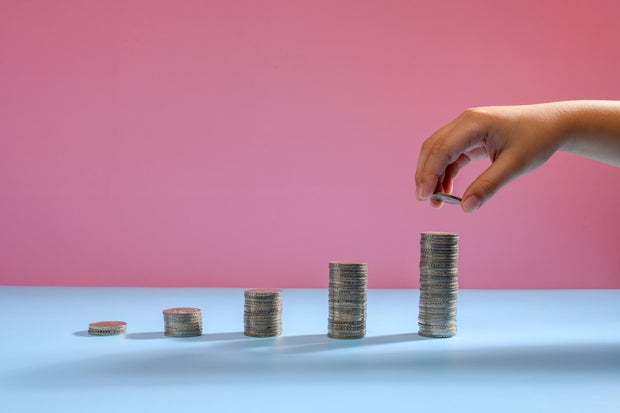$20,000 CD vs. $20,000 high-yield savings account: Here’s which earns more now
Getty Images
If you have $20,000 to invest, you may be contemplating the benefit of getting started in the stock market now. And while current performance looks strong, market uncertainty earlier this year rocked the savings and retirement portfolios of many Americans. The current climate, meanwhile, is hard to navigate, thanks to a combination of inflation, interest rates and changing economic policies. So while it may still be advantageous to play the market with $20,000, it’s also a risk many savers may not feel comfortable with right now.
This is where certificates of deposit (CDs) and high-yield savings accounts come into play. Both offer savers a safe place to keep their money as the principal deposit won’t be impacted by market conditions. And both come with elevated interest rates that are many times higher than what’s available with a traditional savings account now. But those rates aren’t identical, and CD rates are fixed while high-yield savings account rates are variable and likely to change over time. Plus, CDs will require savers keep their money untouched until the account matures while high-yield savings accounts will keep the funds accessible.
Before getting started, then, it helps to calculate the interest-earnings opportunity with both account types. Between a $20,000 CD and a $20,000 high-yield savings account, which earns more right now? That’s what we’ll calculate below.
Start earning more interest on your money with a high-rate CD account here.
$20,000 CD vs. $20,000 high-yield savings account: Here’s which earns more now
CD interest rates vary based on the term in question. Right now, rates tend to be higher on short-term CDs than they are on long-term ones. Here, then, is what a $20,000 deposit into each account type would earn now, based on readily available rates and the assumption that the high-yield savings account rate remains static:
- $20,000 3-month CD at 4.40%: $216.46
- $20,000 high-yield savings account at 4.30% after three months: $211.62
- Difference between the two accounts: The CD earns $4.84 more
- $20,000 6-month CD at 4.49%: $444.07
- $20,000 high-yield savings account at 4.30% after six months: $425.47
- Difference between the two accounts: The CD earns $18.60 more
- $20,000 9-month CD at 4.26%: $635.66
- $20,000 high-yield savings account at 4.30% after nine months: $641.59
- Difference between the two accounts: The high-yield savings account earns $5.93 more
- $20,000 1-year CD at 4.40%: $880.00
- $20,000 high-yield savings account at 4.30% after one year: $860.00
- Difference between the two accounts: The CD earns $20.00 more
- $20,000 18-month CD at 4.26%: $1,291.52
- $20,000 high-yield savings account at 4.30% after 18 months: $1,303.77
- Difference between the two accounts: The high-yield savings account earns $12.25 more
- $20,000 2-year CD at 4.20%: $1,715.28
- $20,000 high-yield savings account at 4.30% after two years: $1,756.98
- Difference between the two accounts: The high-yield savings account earns $41.70 more
In these six circumstances, the CD earns more money in three of them. But it’s important to note that there are other CD terms (like 3-year and 5-year CDs) in which this dynamic may be different. It’s also important to be realistic about the long-term interest-earning potential of high-yield savings accounts. Today’s available rates are unlikely to be the same in three months, let alone one year or longer. So savers will need to account for that volatility before getting started.
Compare your CD and high-yield savings account options here to learn more.
The bottom line
Both CDs and high-yield savings accounts offer savers secure and reliable ways to store their $20,000 deposit right now. If you want a fixed return, a CD could be the option to pursue and if you want a high return that could change over time but that will still allow you access to your money, a high-yield savings account could be better. But remember that this isn’t an “either/or” decision. For some savers, the best recourse is to split the $20,000 between both accounts, allowing you to earn substantial amounts of interest while still keeping a portion of your funds accessible as needed.
You may be interested

Judas Priest’s Rob Halford ‘Bawled’ After Ozzy Osbourne’s Death
new admin - Aug 20, 2025[ad_1] Black Sabbath singer Ozzy Osbourne died of a heart attack aged 76 on July 22 Judas Priest frontman Rob…

Man accused of stalking family of slain UnitedHealthcare CEO put on leave from government job
new admin - Aug 20, 2025[ad_1] A New York state Department of Health employee who was charged with stalking and harassing family members of the…

Jon Batiste brings gospel, blues, and rock to new album, "Big Money"
new admin - Aug 20, 2025Fresh off his Central Park concert, Jon Batiste sits down with "CBS Mornings" to share the inspiration behind "Big Money,"…
































